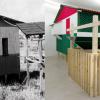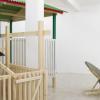
Acre: Rural School is a case study of a school built in the
forest in the Brazilian state of Acre in Amazonia. Elevated on stilts
and constructed of brightly painted local wood, the building is a
roofed open structure with a small room for a kitchen at the back. The
roofed open structure is a typical building typology of the region
that existed long before colonial architecture introduced walls.
The school is equipped with solar panels (on top of the chicken
coop) and a satellite dish: in other words, in a remote area without
access to a power grid, the school nevertheless has its own source
of energy and a means for communicating with other forest
communities and, indeed, with the world at large. Local residents
call such a school a 'power kit', meaning that it is a source of
knowledge, communication, and electrical power. After school hours,
the building becomes a community center, so the whole village
benefits from it.
Acre: Rural School represents an example of an
inspiring collaboration between the Acre state government (which
provides the technology) and the people who live on extraction
reserves (self-managed sustainable territories). During the past two
decades, forest communities and the government have been working
together to create sustainable communities in the forest with the
goal of empowering local residents and avoiding the overexploitation
of forest. Their citizenship -- Florestania -- is based on new
values such as the cultivation of small-scale economies, the
preservation of local knowledge, and control over their land.




